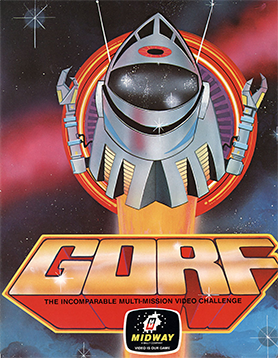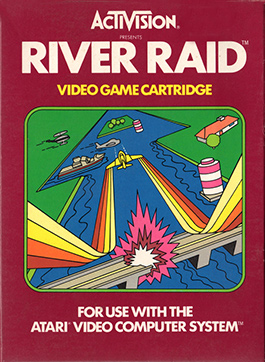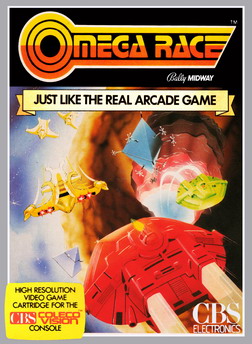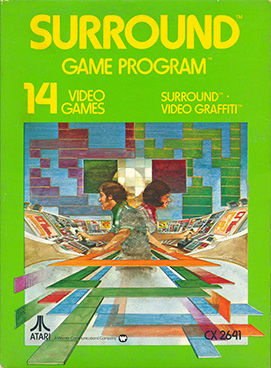
Asteroids is a multidirectional shooter video game developed and published by Atari for arcades. It was designed by Lyle Rains and Ed Logg. The player controls a single spaceship in an asteroid field which is periodically traversed by flying saucers. The object of the game is to shoot and destroy the asteroids and saucers, while not colliding with either, or being hit by the saucers' counter-fire. The game becomes harder as the number of asteroids increases.

The Atari 2600 is a home video game console developed and produced by Atari, Inc. Released in September 1977 as the Atari Video Computer System, it popularized microprocessor-based hardware and games stored on swappable ROM cartridges, a format first used with the Fairchild Channel F in 1976. The VCS was bundled with two joystick controllers, a conjoined pair of paddle controllers, and a game cartridge—initially Combat and later Pac-Man. Sears sold the system as the Tele-Games Video Arcade. Atari rebranded the VCS as the Atari 2600 in November 1982, alongside the release of the Atari 5200.

Missile Command is a 1980 shoot 'em up video game developed and published by Atari for arcades. Sega released the game outside North America. It was designed by Dave Theurer, who also designed Atari's vector graphics game Tempest from the same year. The game was released during the Cold War, and the player uses a trackball to defend six cities from intercontinental ballistic missiles by launching anti-ballistic missiles from three bases.

Adventure is a 1980 action-adventure game developed by Warren Robinett and published by Atari, Inc. for the Atari Video Computer System. The player controls a square avatar whose quest is to explore an open-ended environment to find a magical chalice and return it to the golden castle. The game world is populated by roaming enemies: three dragons that can eat the avatar and a bat that randomly steals and moves items around the game world. Adventure introduced new elements to console games, including enemies that continue to move when offscreen.

Gorf is an arcade video game released in 1981 by Dave Nutting Associates. It is a fixed shooter with five distinct levels, the first of which is based on Space Invaders and another on Galaxian. The game makes use of synthesized speech for the Gorfian robot which taunts the player, powered by a speech chip. Gorf allows the player to buy two additional lives per quarter before starting the game, for a maximum of seven lives.

Tempest is a 1981 arcade video game by Atari, Inc., designed and programmed by Dave Theurer. It takes place on a three-dimensional surface divided into lanes, sometimes as a closed tube, and viewed from one end. The player controls a claw-shaped "blaster" that sits on the edge of the surface, snapping from segment to segment as a rotary knob is turned, and can fire blaster shots to destroy enemies and obstacles by pressing a button.

Combat is a 1977 shooter video game developed and published by Atari for the Atari Video Computer System. In the game, two players controlling either a tank, a biplane, or a jet fire missiles at each other for two minutes and sixteen seconds. Points are scored by hitting the opponent, and the player with more points when the time runs out wins. Variations on the gameplay introduce elements such as invisible vehicles, missiles that ricochet off of walls, and different playing fields.

Gravitar is a color vector graphics multidirectional shooter arcade video game released by Atari, Inc. in 1982. Using the same "rotate-and-thrust" controls as Asteroids and Space Duel, the game was known for its high level of difficulty. It was the first of over twenty games that Mike Hally designed and produced for Atari. The main programmer was Rich Adam and the cabinet art was designed by Brad Chaboya. 5,427 cabinets were produced. An Atari 2600 version by Dan Hitchens was published by Atari in 1983.

Dragonstomper is a video game developed by Stephen Landrum for the Atari Video Computer System and released by Starpath. The game follows the adventures of a dragon hunter who is given a quest by the king to defeat a dragon and reclaim a magical amulet that was stolen. The player makes their way over the countryside, vanquishing various adversaries and gaining gold and experience. After achieving enough strength, the player can enter a shop in an oppressed village where equipment can be purchased, soldiers hired, and special scrolls obtained to defeat the dragon in its lair.

Haunted House is a 1982 adventure video game programmed by James Andreasen for the Atari Video Computer System and published by Atari. The player controls an avatar shaped like a pair of eyes who explores a mansion seeking out parts of an urn to return to the entrance. The game world is populated by roaming enemies including vampire bats, tarantulas, and a ghost. Haunted House was among the first games to use player-controlled scrolling between large portions of the visual space.

River Raid is a 1982 shoot 'em up video game developed and published by Activision for the Atari 2600. Designed by Carol Shaw, the player controls a fighter jet over the River of No Return in a raid behind enemy lines. The goal is to navigate the flight by destroying enemy tankers, helicopters, fuel depots and bridges without running out of fuel or crashing.

The Atari Flashback is a line of dedicated video game consoles produced since 2004, currently designed, produced, published and marketed by AtGames under license from Atari SA. The Flashback consoles are "plug-and-play" versions of the 1970s Atari 2600 console with built-in games rather than using ROM cartridges. The latest home console model, Atari Flashback 12 Gold, was released in 2023 and has 130 games.

Air-Sea Battle is a fixed shooter developed and published by Atari, Inc. for the Atari Video Computer System. The game was designed by Larry Kaplan who joined Atari in 1976. It was the first game he developed for the company. Air-Sea Battle involves the player controlling a gun to shoot down various targets to earn points in different themed areas. In the various gameplay modes, the player can either control the angle of the gun or move the gun across the screen or adjust the guns speed as it automatically moves for aiming.

Star Ship is a first-person space combat simulator video game programmed by Bob Whitehead and published by Atari, Inc. for its Video Computer System. The game was one of the nine launch titles offered when the Atari VCS was released on September 11, 1977. Based on the Atari arcade game Starship 1, it was the first space-related game developed for the Atari VCS. The re-branded Sears TeleGames version is titled Outer Space.

Omega Race is a shoot 'em up arcade video game designed by Ron Haliburton and released in 1981 by Midway. It is the only arcade game with vector graphics that Midway created.

Star Wars: The Empire Strikes Back is a scrolling shooter video game programmed by Rex Bradford for the Atari 2600 and published by Parker Brothers in 1982. It was the first licensed Star Wars video game. An Intellivision version was released in 1983.

Surround is a video game programmed by Alan Miller and published by Atari, Inc. for the Atari Video Computer System. In the game, players navigate a continuously moving block around an enclosed space as a wall trails behind it. Every time the opposite player hits a wall with their block, the other player earns a single point. The first player to reach ten points is the winner.

Atari Vault is a video game collection developed by Code Mystics and published by Atari Interactive for Microsoft Windows, macOS, and Linux via the Steam client. Atari Vault contains titles from Atari, Inc. and Atari Corporation published on the Atari 2600 and arcade cabinets. dating from the 1970s, 1980s, and 1990s. The games, where possible, have been updated to include modern-day features such as local and online multiplayer and online leaderboards.

The Atari VCS is a home video game console produced by Atari VCS, LLC, an affiliate of Atari, Inc. part of the Atari SA group. While its exterior encasing design is intended to pay homage to the Atari 2600, the new Atari VCS plays modern games and streaming entertainment via a Linux-based operating system called AtariOS that allows users to download and install other compatible games, including those compatible with Windows 10. The system shares a name with the original Atari's 1977 Video Computer System, usually shortened to VCS, which was renamed to the Atari 2600 in late 1982.



















